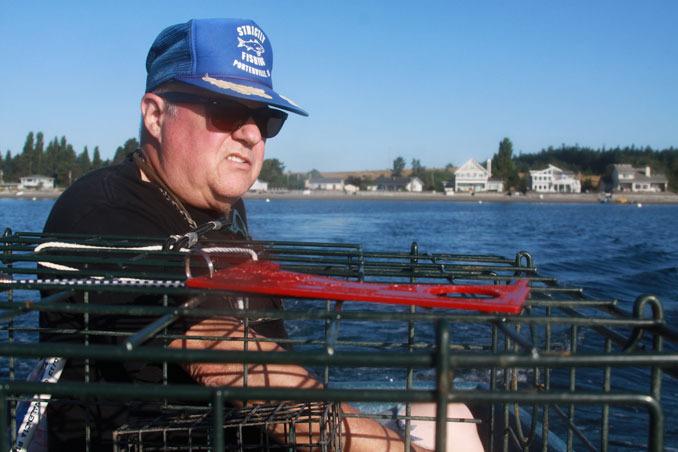Crabs aren’t finicky when it comes to taste.
Doug Rollin of Oak Harbor has tried all sorts of different baits to try to catch Dungeness crabs in Puget Sound.
The only thing that didn’t work was a common garden slug.
“I’ll tell you what,” Rollin said. “I did catch crabs with a pair of old trousers with bacon grease smeared on it.”
Greased trousers, chicken legs, cat food, fish heads, you name it — everyone has a favorite method he or she swears will cause a crab to clamp down on tight.
THE POPULAR recreational crab fishery started Thursday in Puget Sound, sending crab fishers out in mass armed with all sorts of attractants aimed at trapping the eight-legged crustaceans.
Each year, from July to September, sports fishers catch more than 1 million pounds of Dungeness crab in Puget Sound.
Not only do many consider the catch a delicacy, another appeal is that success rates are higher that most other fisheries, including salmon fishing.
“For catching crab, nearly any bait works, some better than others,” said John Hudson, one of North Whidbey’s resident experts on crabbing. “This is one of the highest-probability-of-success sports fishing endeavors.
“You’d have to be pretty hard-pressed not to have success.”
HUDSON TRIES to get out on his boat several times a week to drop his crab pots between Strawberry Point and Polnell Point outside Oak Harbor and learn a little more about the recreational crab fishery he’s enjoyed in Washington for nearly 40 years.
He teaches crab seminars for the Deception Pass Sail & Power Squadron, using a PowerPoint presentation to share what gear to use, which methods to try, when and where to drop pots around Whidbey Island and every other imaginable detail to educate the local crabber.
“Long soaks improve odds,” Hudson said.
Hudson prefers to dig cockle clams on a beach near his North Whidbey home to use for crab bait.
“I like clams because it is their natural food,” Hudson said. “They eat more clams than anything else.”
Hudson said he can only remember one time in 2014 when he didn’t catch his daily limit of five Dungeness crabs, which must be a minimum 61/4 inches wide or get tossed back.
THE CRAB caught also must be male and in hardshell condition.
To differentiate the sexes, look at the crab’s underside. Females have a wider abdomen than males.
Fishers also are allowed to keep six Red Rock crabs per day. They must be a minimum of 5 inches wide and can be either sex.
One of the differences between a Dungeness crab and Red Rock is the Dungeness crab has white-tipped claws and a brownish shell. Red Rock crabs have black-tipped claws and a reddish shell.
Hudson said there are a variety of ways to catch crab and not all require a boat.
Crabs can be caught by tossing a ringnet, by hand or with a snare.
He’s even seen fishers have success with hand lines and dip nets, particularly near eel grass.
CORNET BAY, on North Whidbey, is a popular place to fish for crab for those not using a boat, Hudson said.
Fishers may toss out casting traps, star traps and ringnets from a pier or even try a crude hand-line method.
Hudson suggests tying a grisly piece of meat to a line and tossing it from a pier and having a net ready to plunge into the water because most crabs will let go of the bait once they get near the surface and finally realize what’s going on.
Crabbers must follow a litany of rules to legally harvest crabs. Washington Sports Fishing Rules pamphlets can be hard to come by these days at local stores that sell fishing gear, so a good place to look is on the Washington Department of Fish and Wildlife’s website at www.wdfw.wa.gov/fishing/shellfish/crab
Crabbing is allowed every day of the week except Tuesdays and Wednesdays through Sept. 7.
Every crab fisher harvesting Dungeness crab in Puget Sound must have a shellfish license and crab endorsement card, which combined cost about $25 for fishers ages 16 to 69 with those 70 and older receiving a significant discount.
ACE HARDWARE in Oak Harbor has been selling more than 100 of such licenses per day this week leading up to the July 2 opener. Walmart, among other stores, also sells sports fishing licenses.
Only two units of gear may be used by each crabber. Units of gear include pots, star traps and ringnets.
Those who leave pots in the water must attach a red-and-white buoy to their leaded rope and write their full name and address on the buoy.
All waters around Whidbey are open to crabbing.
Wear rubber boots to keep your feet dry, bring a crab measurer and wear gloves to avoid any irritation from the slime of jellyfish that tends to stick to ropes, said Oak Harbor’s Connie Ross, a crabber for most of her life.
Don’t simply use a dollar bill to measure a crab, she said. Legal crabs are a little larger than that.
And, of course, don’t forget the bait.
“Turkey legs are the best bait,” Ross said.
“I get the best results from turkey.”



